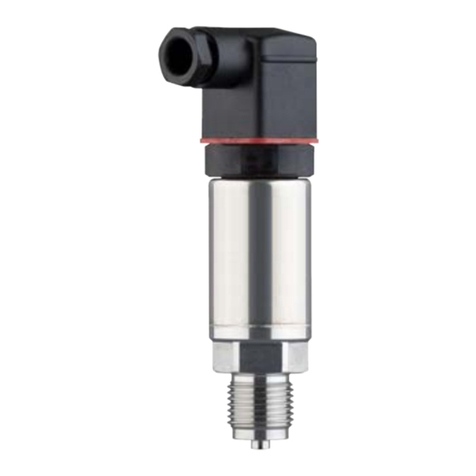Vega VEGAPULS 67 User manual

Operating Instructions
Radar sensor for continuous level
measurement of bulk solids
VEGAPULS 67
Probus PA
Document ID: 36533

2
Contents
VEGAPULS 67 • Probus PA
36533-EN-170405
Contents
1 About this document
1.1 Function ........................................................................................................................... 4
1.2 Target group ..................................................................................................................... 4
1.3 Symbols used................................................................................................................... 4
2 For your safety
2.1 Authorised personnel ....................................................................................................... 5
2.2 Appropriate use................................................................................................................ 5
2.3 Warning about incorrect use............................................................................................. 5
2.4 General safety instructions............................................................................................... 5
2.5 EU conformity................................................................................................................... 6
2.6 NAMUR recommendations .............................................................................................. 6
2.7 Radio license for Europe .................................................................................................. 6
2.8 Radio license for USA ...................................................................................................... 7
2.9 Radio license for Canada ................................................................................................. 7
2.10 Environmental instructions ............................................................................................... 9
3 Product description
3.1 Conguration.................................................................................................................. 10
3.2 Principle of operation...................................................................................................... 11
3.3 Packaging, transport and storage................................................................................... 11
3.4 Accessories and replacement parts ............................................................................... 12
4 Mounting
4.1 General instructions ....................................................................................................... 14
4.2 Collar or adapter ange.................................................................................................. 15
4.3 Mounting strap ............................................................................................................... 15
4.4 Mounting instructions ..................................................................................................... 17
5 Connecting to the bus system
5.1 Preparing the connection ............................................................................................... 27
5.2 Connecting..................................................................................................................... 28
5.3 Wiring plan, single chamber housing.............................................................................. 29
5.4 Wiring plan, double chamber housing ............................................................................ 30
5.5 Wiring plan, double chamber housing Ex d ia ................................................................ 32
5.6 Double chamber housing with VEGADIS-Adapter.......................................................... 33
5.7 Wiring plan - version IP 66/IP 68, 1 bar........................................................................... 34
5.8 Set instrument address .................................................................................................. 34
5.9 Switch-on phase............................................................................................................. 35
6 Set up with the display and adjustment module
6.1 Insert display and adjustment module............................................................................ 36
6.2 Adjustment system......................................................................................................... 37
6.3 Measured value indication - Selection of national language........................................... 39
6.4 Parameter adjustment .................................................................................................... 39
6.5 Saving the parameterisation data................................................................................... 58
7 Setup with PACTware
7.1 Connect the PC.............................................................................................................. 59
7.2 Parameter adjustment .................................................................................................... 59
7.3 Saving the parameterisation data................................................................................... 60

3
Contents
VEGAPULS 67 • Probus PA
36533-EN-170405
8 Set up with other systems
8.1 DD adjustment programs ............................................................................................... 61
9 Diagnosis, asset management and service
9.1 Maintenance .................................................................................................................. 62
9.2 Measured value and event memory ............................................................................... 62
9.3 Asset Management function........................................................................................... 63
9.4 Rectify faults................................................................................................................... 66
9.5 Exchanging the electronics module................................................................................ 69
9.6 Software update ............................................................................................................. 70
9.7 How to proceed if a repair is necessary.......................................................................... 70
10 Dismount
10.1 Dismounting steps.......................................................................................................... 71
10.2 Disposal ......................................................................................................................... 71
11 Supplement
11.1 Technical data ................................................................................................................ 72
11.2 Communication Probus PA........................................................................................... 79
11.3 Dimensions .................................................................................................................... 83
11.4 Industrial property rights................................................................................................. 91
11.5 Trademark ...................................................................................................................... 91
Safety instructions for Ex areas
Take note of the Ex specic safety instructions for Ex applications.
These instructions are attached as documents to each instrument
with Ex approval and are part of the operating instructions manual.
Editing status: 2017-04-03

4
1 About this document
VEGAPULS 67 • Probus PA
36533-EN-170405
1 About this document
1.1 Function
This operating instructions manual provides all the information you
need for mounting, connection and setup as well as important instruc-
tions for maintenance and fault rectication. Please read this informa-
tion before putting the instrument into operation and keep this manual
accessible in the immediate vicinity of the device.
1.2 Target group
This operating instructions manual is directed to trained specialist
personnel. The contents of this manual should be made available to
these personnel and put into practice by them.
1.3 Symbols used
Information, tip, note
This symbol indicates helpful additional information.
Caution: If this warning is ignored, faults or malfunctions can result.
Warning: If this warning is ignored, injury to persons and/or serious
damage to the instrument can result.
Danger: If this warning is ignored, serious injury to persons and/or
destruction of the instrument can result.
Ex applications
This symbol indicates special instructions for Ex applications.
• List
The dot set in front indicates a list with no implied sequence.
→ Action
This arrow indicates a single action.
1 Sequence of actions
Numbers set in front indicate successive steps in a procedure.
Battery disposal
This symbol indicates special information about the disposal of bat-
teries and accumulators.

5
2 For your safety
VEGAPULS 67 • Probus PA
36533-EN-170405
2 For your safety
2.1 Authorised personnel
All operations described in this operating instructions manual must
be carried out only by trained specialist personnel authorised by the
plant operator.
During work on and with the device the required personal protective
equipment must always be worn.
2.2 Appropriate use
VEGAPULS 67 is a sensor for continuous level measurement.
You can nd detailed information about the area of application in
chapter "Product description".
Operational reliability is ensured only if the instrument is properly
used according to the specications in the operating instructions
manual as well as possible supplementary instructions.
2.3 Warning about incorrect use
Inappropriate or incorrect use of the instrument can give rise to
application-specic hazards, e.g. vessel overll or damage to system
components through incorrect mounting or adjustment. Also the pro-
tective characteristics of the instrument can be inuenced.
2.4 General safety instructions
This is a state-of-the-art instrument complying with all prevailing
regulations and directives. The instrument must only be operated in a
technically awless and reliable condition. The operator is responsible
for the trouble-free operation of the instrument.
During the entire duration of use, the user is obliged to determine the
compliance of the necessary occupational safety measures with the
current valid rules and regulations and also take note of new regula-
tions.
The safety instructions in this operating instructions manual, the na-
tional installation standards as well as the valid safety regulations and
accident prevention rules must be observed by the user.
For safety and warranty reasons, any invasive work on the device
beyond that described in the operating instructions manual may be
carried out only by personnel authorised by the manufacturer. Arbi-
trary conversions or modications are explicitly forbidden.
The safety approval markings and safety tips on the device must also
be observed.
Depending on the instrument version, the emitting frequencies are in
the C, K or W band range. The low emission power is far below the
internationally approved limit values. When used correctly, the device
poses no danger to health.

6
2 For your safety
VEGAPULS 67 • Probus PA
36533-EN-170405
2.5 EU conformity
The device fulls the legal requirements of the applicable EU direc-
tives. By axing the CE marking, we conrm the conformity of the
instrument with these directives.
You can nd the EU conformity declaration on our website under
www.vega.com/downloads.
Electromagnetic compatibility
Instruments in four-wire or Ex-d-ia version are designed for use in an
industrial environment. Nevertheless, electromagnetic interference
from electrical conductors and radiated emissions must be taken into
account, as is usual with class A instruments according to EN 61326-
1. If the instrument is used in a dierent environment, the electromag-
netic compatibility to other instruments must be ensured by suitable
measures.
2.6 NAMUR recommendations
NAMUR is the automation technology user association in the process
industry in Germany. The published NAMUR recommendations are
accepted as the standard in eld instrumentation.
The device fulls the requirements of the following NAMUR recom-
mendations:
• NE 21 – Electromagnetic compatibility of equipment
• NE 53 – Compatibility of eld devices and display/adjustment
components
• NE 107 - Self-monitoring and diagnosis of eld devices
For further information see www.namur.de.
2.7 Radio license for Europe
The instrument was tested according to the latest issue of the follow-
ing harmonized standards:
• EN 302372 - Tank Level Probing Radar
It is hence approved for use inside closed vessels in countries of the
EU.
Use is also approved in EFTA countries, provided the respective
standards have been implemented.
For operation inside of closed vessels, the following conditions must
be fullled:
• The instrument must be permanently mounted on a closed vessel
made of metal, reinforced concrete, or comparable attenuating
materials
• Flanges, process ttings and mounting accessories must ensure
the microwave impermeability of the vessel and not let the radar
signal escape to the outside
• If necessary, existing viewing windows in the vessel must be
coated with a microwave impermeable material (e.g. electrically
conductive coating)

7
2 For your safety
VEGAPULS 67 • Probus PA
36533-EN-170405
• Manholes and anges on the vessel must be closed and sealed to
avoid penetration of the radar signal
• The instrument should be preferably mounted on top of the vessel
with antenna orientation downward
• The instrument must only be installed and maintained by appropri-
ately qualied sta
2.8 Radio license for USA
This approval is only valid for USA. Hence the following text is only
available in the English language.
This device complies with Part 15 of the FCC Rules. Operation is
subject to the following two conditions:
• This device may not cause interference, and
• This device must accept any interference, including interference
that may cause undesired operation of the device
This device is approved for unrestricted use only inside closed, sta-
tionary vessels made of metal, concrete and reinforced berglass.
For operation outside of closed vessels, the following conditions must
be fullled:
• This device shall be installed and maintained to ensure a verti-
cally downward orientation of the transmit antenna's main beam.
Furthermore, the use of any mechanism that does not allow the
main beam of the transmitter to be mounted vertically downward is
prohibited.
• This device shall be installed only at xed locations. The LPR
device shall not operate while being moved or while inside a mov-
ing container.
• Hand-held applications are prohibited.
• Marketing to residential consumers is prohibited.
Changes or modications not expressly approved by the manufac-
turer could void the user’s authority to operate this equipment.
2.9 Radio license for Canada
This approval is only valid for Canada. Hence the following texts are
only available in the English/French language.
This device complies with Industry Canada's license-exempt RSS
standards. Operation is subject to the following conditions:
• This device may not cause interference, and
• This device must accept any interference, including interference
that may cause undesired operation of the device
This device has been approved for both closed containers and open-
air environments with the following limitations:
• Closed Containers: For installations utilizing a tilt during installa-
tion: This device is limited to installation in a completely enclosed
container made of metal, concrete or reinforced berglass to pre-
vent RF emissions, which can otherwise interfere with aeronauti-
cal navigation, the maximum approved tilt angle is 10°.

8
2 For your safety
VEGAPULS 67 • Probus PA
36533-EN-170405
• Open Air Environment: For operation outside of closed vessels,
the following condition must be fullled: This device shall be
installed and maintained to ensure a vertically downward orienta-
tion of the transmit antenna's main beam. Furthermore, the use of
any mechanism that does not allow the main beam of the transmit-
ter to be mounted vertically downward is prohibited.
The installation of the LPR/TLPR device shall be done by trained
installers, in strict compliance with the manufacture's instructions.
This device shall be installed only at xed locations. The LPR device
shall not operate while being moved or while inside a moving con-
tainer.
Hand-held applications are prohibited.
Marketing to residential consumers is prohibited.
The use of this device is on a "no-interference, no-protection" basis.
That ist, the user shall accept operatings of high-powered radaar in
the same frequency band which may interfere with or damage this
device.
However, devices found to interfere with primary licensing operations
will be required to be removed at the user's expense.
The installer/user of this device shall ensure that it is at least 10 km
from the Dominion Astrophysical Radio Observatory (DRAO) near
Penticton, British Columbia. The coordinates of the DRAO are latitude
49°19′15″ N and longitude 119°37′12″W. For devices not meeting
this 10 km separation (e.g., those in the Okanagan Valley, British Co-
lumbia,) the installer/user must coordinate with, and obtain the written
concurrence of, the Director of the DRAO before the equipment can
be installed or operated. The Director of the DRAO may be contacted
at 250-497-2300 (tel.)or 250-497-2355 (fax). (Alternatively, the Man-
ager, Regulatory Standards, Industry Canada, may be contacted.)
Le présent appareil est conforme aux CNR d’Industrie Canada ap-
plicables aux appareils radio exempts de licence. L’exploitation est
autorisée aux conditions suivantes:
• L’appareil ne doit pas produire de brouillage; et
• L’utilisateur de l’appareil doit accepter tout brouillage radioélect-
rique subi, même si le brouillage est susceptible d’en compromet-
tre le fonctionnement.
Cet appareil est homologué pour une utilisation dans les cuves fer-
mées et les environnements ouverts avec les restrictions suivantes :
• Cuves fermées : Pour les installations impliquant une inclinaison
lors de l'installation : cet appareil ne doit être installé que dans une
cuve totalement fermée en en métal, en béton ou en matière plas-
tiqe renforcée de bres de verre, pour empêcher les émissions RF
susceptibles d'interférer avec la navigation aéronautique. L'angle
d'inclinaison maximum autorisé est de 10°.
• Environnement ouvert : Pour l'utilisation hors des cuves fermées,
la condition suivante doit être remplie : L'appareil doit être installé
et entretenu de manière à garantir une orientation verticale vers
le bas du faisceau principal de l’antenne émettrice. De plus,

9
2 For your safety
VEGAPULS 67 • Probus PA
36533-EN-170405
l’utilisation de tout mécanisme ne permettant pas l’orientation ver-
ticale vers le bas du faisceau principal de l’émetteur est interdite
L’installation d’un dispositif LPR ou TLPR doit être eectuée par des
installateurs qualiés, en pleine conformité avec les instructions du
fabricant.
Cet appareil ne doit être installé qu'à des emplacements xes.
L’appareil LPR ne doit pas être utilisé pendant qu’il est en train d’être
déplacé ou se trouve dans un conteneur en mouvement.
Les applications portables sont interdites.
La vente à des particuliers est interdite
Ce dispositif ne peut être exploité qu'en régime de non-brouillage
et de non-protection, c'est-à-dire que l'utilisateur doit accepter que
des radars de haute puissance de la même bande de fréquences
puissent brouiller ce dispositif ou même l'endommager. D'autre part,
les capteurs de niveau qui perturbent une exploitation autorisée par
licence de fonctionnement principal doivent être enlevés aux frais de
leur utilisateur.
La personne qui installe/utilise ce capteur de niveau doit s'assurer
qu'il se trouve à au moins 10 km de l'Observatoire fédéral de radioas-
trophysique (OFR) de Penticton en Colombie-Britannique. Les coor-
données de l'OFR sont : latitude N 49° 19′ 15″, longitude O 119° 37′
12″. La personne qui installe/utilise un dispositif ne pouvant respecter
cette distance de 10km (p. ex. dans la vallée de l'Okanagan [Colom-
bie-Britannique]) doit se concerter avec le directeur de l'OFR an
d’obtenir de sa part une autorisation écrite avant que l'équipement
ne puisse être installé ou mis en marche. Le directeur de l'OFR peut
être contacté au 250-497-2300 (tél.) ou au 250-497-2355 (fax). (Le
Directeur des Normes réglementaires d'Industrie Canada peut égale-
ment être contacté).
2.10 Environmental instructions
Protection of the environment is one of our most important duties.
That is why we have introduced an environment management system
with the goal of continuously improving company environmental pro-
tection. The environment management system is certied according
to DIN EN ISO 14001.
Please help us full this obligation by observing the environmental
instructions in this manual:
• Chapter "Packaging, transport and storage"
• Chapter "Disposal"

10
3 Product description
VEGAPULS 67 • Probus PA
36533-EN-170405
3 Product description
3.1 Conguration
The type label contains the most important data for identication and
use of the instrument:
2
1
15
13
14
12
11
5
3
6
4
7
8
10
9
Fig. 1: Layout of the type label (example)
1 Instrument type
2 Product code
3 Approvals
4 Power supply and signal output, electronics
5 Protection rating
6 Measuring range
7 Process and ambient temperature, process pressure
8 Material, wetted parts
9 Hardware and software version
10 Order number
11 Serial number of the instrument
12 Data matrix code for smartphone app
13 Symbol of the device protection class
14 ID numbers, instrument documentation
15 Reminder to observe the instrument documentation
The type label contains the serial number of the instrument. With it
you can nd the following instrument data on our homepage:
• Product code (HTML)
• Delivery date (HTML)
• Order-specic instrument features (HTML)
• Operating instructions and quick setup guide at the time of ship-
ment (PDF)
• Order-specic sensor data for an electronics exchange (XML)
• Test certicate (PDF) - optional
Go to "www.vega.com", "Instrument search (serial number)". Enter
the serial number.
Alternatively, you can access the data via your smartphone:
• Download the smartphone app "VEGA Tools" from the "Apple App
Store" or the "Google Play Store"
• Scan the Data Matrix code on the type label of the instrument or
• Enter the serial number manually in the app
Type label
Serial number - Instru-
ment search

11
3 Product description
VEGAPULS 67 • Probus PA
36533-EN-170405
This operating instructions manual applies to the following instrument
versions:
• Hardware from 2.1.1
• Software from 4.5.0
The scope of delivery encompasses:
• Radar sensor
• Mounting strap with xing material (optional)
• Documentation
– Quick setup guide VEGAPULS 67
– Instructions for optional instrument features
– Ex-specic "Safety instructions" (with Ex versions)
– If necessary, further certicates
• DVD "DTM Collection", included therein
– PACTwa re
– DTM Collection
– Instrument master les (GSD) for Probus PA
– FDT certicates
Information:
The optional instrument features are described in the operating
instructions manual. The respective scope of delivery results from the
order specication.
3.2 Principle of operation
The VEGAPULS 67 is a radar sensor for continuous level measure-
ment of bulk solids under simple process conditions. It is suitable for
smaller silos and vessels.
The instrument is also suitable for applications in liquids.
The antenna of the radar sensor emits short radar pulses with a
duration of approx. 1 ns. These pulses are reected by the product
and received by the antenna as echoes. The transit time of the radar
pulses from emission to reception is proportional to the distance and
hence to the level. The determined level is converted into an appropri-
ate output signal and outputted as measured value.
3.3 Packaging, transport and storage
Your instrument was protected by packaging during transport. Its
capacity to handle normal loads during transport is assured by a test
based on ISO 4180.
The packaging of standard instruments consists of environment-
friendly, recyclable cardboard. For special versions, PE foam or PE
foil is also used. Dispose of the packaging material via specialised
recycling companies.
Transport must be carried out in due consideration of the notes on the
transport packaging. Nonobservance of these instructions can cause
damage to the device.
Scope of this operating
instructions manual
Scope of delivery
Application area
Functional principle
Packaging
Transport

12
3 Product description
VEGAPULS 67 • Probus PA
36533-EN-170405
The delivery must be checked for completeness and possible transit
damage immediately at receipt. Ascertained transit damage or con-
cealed defects must be appropriately dealt with.
Up to the time of installation, the packages must be left closed and
stored according to the orientation and storage markings on the
outside.
Unless otherwise indicated, the packages must be stored only under
the following conditions:
• Not in the open
• Dry and dust free
• Not exposed to corrosive media
• Protected against solar radiation
• Avoiding mechanical shock and vibration
• Storage and transport temperature see chapter "Supplement -
Technical data - Ambient conditions"
• Relative humidity 20 … 85 %
3.4 Accessories and replacement parts
The display and adjustment module PLICSCOM is used for measured
value indication, adjustment and diagnosis. It can be inserted into the
sensor and removed at any time.
The integrated Bluetooth module (optional) enables wireless adjust-
ment via standard adjustment devices:1)
• Smartphone/tablet (iOS or Android operating system)
• PC/notebook with Bluetooth USB adapter (Windows operating
system)
You can nd further information in the operating instructions "Display
and adjustment module PLICSCOM" (Document-ID 27835).
The interface adapter VEGACONNECT enables the connection of
communication-capable instruments to the USB interface of a PC. For
parameter adjustment of these instruments, the adjustment software
PACTware with VEGA-DTM is required.
You can nd further information in the operating instructions "Interface
adapter VEGACONNECT" (Document-ID 32628).
The VEGADIS 81 is an external display and adjustment unit for VEGA
plics®sensors.
For sensors with double chamber housing the interface adapter
"VEGADIS adapter" is also required for VEGADIS 81.
You can nd further information in the operating instructions
"VEGADIS 81" (Document-ID 43814).
The VEGADIS adapter is an accessory part for sensors with double
chamber housings. It enables the connection of VEGADIS 81 to the
sensor housing via an M12 x 1 plug.
Transport inspection
Storage
Storage and transport
temperature
PLICSCOM
VEGACONNECT
VEGADIS 81
VEGADIS adapter
1) Bluetooth function with VEGADIS 82 can only be used at a later date.

13
3 Product description
VEGAPULS 67 • Probus PA
36533-EN-170405
You can nd further information in the supplementary instructions
"VEGADIS adapter" (Document-ID 45250).
PLICSMOBILE T61 is an external GSM/GPRS radio unit for transmis-
sion of measured values and for remote parameter adjustment of
plics® sensors. Adjustment is carried out via PACTware/DTM and the
integrated USB connection.
You can nd further information in the supplementary instructions
"PLICSMOBILE T61" (Document-ID 37700).
PLICSMOBILE is an internal GSM/GPRS radio unit for transmission
of measured values and for remote conguration of plics®sensors.
Adjustment is carried out via PACTware/DTM and the integrated USB
connection.
You can nd further information in the supplementary instructions
"PLICSMOBILE GSM/GPRS radio module" (Document-ID 36849).
The overvoltage arrester B81-35 is used in the single or double
chamber housing instead of the connection terminals. It reduces any
voltage surges that may reach the signal cables to a harmless level.
You can nd further information in the supplementary instructions
"Overvoltage arrester B81-35" (Document-ID 50708).
Screwed anges are available in dierent versions according to the
following standards: DIN 2501, EN 1092-1, BS 10, ASME B 16.5,
JIS B 2210-1984, GOST 12821-80.
You can nd additional information in the supplementary instructions
manual "Flanges according to DIN-EN-ASME-JIS".
The protective cover protects the sensor housing against soiling and
intense heat from solar radiation.
You will nd additional information in the supplementary instructions
manual "Protective cover" (Document-ID 34296).
Electronics module "VEGAPULS series 60" is a replacement part for
radar sensors of VEGAPULS series 60. A dierent version is available
for each type of signal output.
You can nd further information in the operating instructions "Elec-
tronics module VEGAPULS series 60" (Document-ID 36801).
The supplementary electronics is a replacement part for sensors with
Probus PA and double chamber housing.
You can nd further information in the operating instructions "Supple-
mentary electronics for Probus PA" (Document-ID 42767).
PLICSMOBILE T61
PLICSMOBILE
Overvoltage protection
Flanges
Protective cover
Electronics module
Supplementary electron-
icsforProbusPA

14
4 Mounting
VEGAPULS 67 • Probus PA
36533-EN-170405
4 Mounting
4.1 General instructions
On instruments with threaded process tting, the hexagon must be
tightened with a suitable wrench. For the proper wrench size see
chapter "Dimensions".
Warning:
The housing must not be used to screw the instrument in! Applying
tightening force can damage internal parts of the housing.
Protect your instrument against moisture ingress through the following
measures:
• Use the recommended cable (see chapter "Connecting to power
supply")
• Tighten the cable gland
• When mounting horizontally, turn the housing so that the cable
gland points downward
• Loop the connection cable downward in front of the cable gland
This applies mainly to outdoor installations, in areas where high
humidity is expected (e.g. through cleaning processes) and on cooled
or heated vessels.
Make sure before mounting that all parts of the instrument exposed to
the process are suitable for the existing process conditions.
These are mainly:
• Active measuring component
• Process tting
• Process seal
Process conditions in particular are:
• Process pressure
• Process temperature
• Chemical properties of the medium
• Abrasion and mechanical inuences
You can nd detailed information on the process conditions in chapter
"Technical data" as well as on the type label.
Metric threads
In the case of instrument housings with metric thread, the cable
glands are screwed in at the factory. They are sealed with plastic
plugs as transport protection.
You have to remove these plugs before electrical connection.
NPT thread
In the case of instrument housings with self-sealing NPT threads, it is
not possible to have the cable entries screwed in at the factory. The
free openings for the cable glands are therefore covered with red dust
protection caps as transport protection. The dust protection caps do
not provide sucient protection against moisture.
Screwing in
Protection against mois-
ture
Suitability for the process
conditions
Cable glands

15
4 Mounting
VEGAPULS 67 • Probus PA
36533-EN-170405
Prior to setup you have to replace these protective caps with ap-
proved cable glands or close the openings with suitable blind plugs.
4.2 Collaroradapterange
For mounting the instrument on a socket, a combi compression ange
for DN 80 (ASME 3" or JIS 80) is also available for retro tting. Option-
ally, the instrument can be also equipped with an adapter ange from
DN 100 (ASME 4" or JIS 100).
With the housing versions plastic, aluminium single chamber and
stainless steel, the collar ange can be placed directly over the hous-
ing. With the aluminium double chamber housing, retroactive mount-
ing in this way is not possible - the mounting type must be specied
with the order.
You can nd drawings of these mounting options in chapter "Dimen-
sions".
Fig. 2: Flange mounting of the radar sensor
4.3 Mounting strap
The mounting strap enables simple mounting on the vessel wall or
silo top. It is suitable for wall, ceiling or boom mounting. Especially in
open vessels this is a very easy and eective way to align the sensor
to the bulk solid surface.
Mounting strap

16
4 Mounting
VEGAPULS 67 • Probus PA
36533-EN-170405
Fig. 3: Radar sensor with mounting strap
The strap is supplied unassembled and must be screwed to the
sensor before setup with three hexagon socket screws M5 x 10 and
spring washers. Max. torque, see chapter "Technical data". Required
tools: Allen wrench size 4.
There are two ways to screw the strap onto the sensor. Depending
on the selected version, the sensors can be swivelled in the strap as
follows:
• Single chamber housing
– Angle of inclination 180°, innitely variable
– Angle of inclination in three steps 0°, 90° and 180°
• Double chamber housing
– Angle of inclination 90°, innitely variable
– Angle of inclination in two steps 0° and 90°
Fig. 4: Adjustment of the angle of inclination

17
4 Mounting
VEGAPULS 67 • Probus PA
36533-EN-170405
Fig. 5: Turning by fastening in the centre
4.4 Mounting instructions
For tight installation of the version with plastic horn antenna with com-
pression or adapter ange, the following conditions must be fullled:
1. Use suitable at seal, e.g. of EPDM with Shore hardness 25 or 50
2. Make sure the number of ange screws corresponds to the num-
ber of ange holes
3. Tighten all screws with the torque stated in the technical data
The emitted radar impulses of the radar sensor are electromagnetic
waves. The polarisation is the direction of the electrical share. With
radar sensors, the polarisation can be used to reduce the eect of
false echoes considerably by turning the instrument in the connection
ange or mounting boss.
The position of the polarisation is marked on the instrument.
1
Fig. 6: Position of the polarisation
1 Marking bar
Mount the instrument at least 200 mm (7.874 in) away from the vessel
wall.
200 mm
(7.87
")
Fig. 7: Mounting the radar sensor on the vessel top
Tight installation of the
plastic horn antenna
Polarisation
Installation position

18
4 Mounting
VEGAPULS 67 • Probus PA
36533-EN-170405
If you cannot maintain this distance, you should carry out a false
signal suppression during setup. This applies particularly if buildup on
the vessel wall is expected. In such cases, we recommend repeating
the false signal suppression at a later date with existing buildup.
Filling from the top: Mounting should not be too close to the inow-
ing material as the microwave signal will be interferred. The optimum
mounting position is on the opposite of the lling. To avoid strong
pollution, the distance to the lter or dust extraction must be as big as
possible.
Fig. 8: Mounting of the radar sensor with inowing medium - lling from top
Laterallling: With bulk solids silos with lateral pneumatic lling,
mounting should not be in the lling stream as the microwave signal
will be interferred. The optimum mounting position is next to the lling.
To avoid strong pollution, the distance to the lter or dust extraction
must be as big as possible.
Inowingmedium

19
4 Mounting
VEGAPULS 67 • Probus PA
36533-EN-170405
Fig. 9: Mounting of the radar sensor with inowing medium - lling from the side
A corresponding collar ange for DN 80 (ASME 3" or JIS 80) as well
as a suitable adapter ange are available for mounting VEGAPULS
67.
With the housing versions plastic, aluminium single chamber and
stainless steel, the collar ange can be placed directly over the hous-
ing. With the aluminium double chamber housing, retroactive mount-
ing in this way is not possible - the mounting type must be specied
with the order.
Information:
The mounting socket should be as short as possible and its end
rounded. This reduces false echoes from the vessel mounting socket.
Socket with plastic horn
antenna

20
4 Mounting
VEGAPULS 67 • Probus PA
36533-EN-170405
Fig. 10: Recommended socket mounting
If the medium has good reective properties, VEGAPULS 67 can
also be mounted on a longer socket piece. Recommended values
for socket heights are specied in the following illustration. You must
carry out a false echo storage afterwards.
d
h
The below charts specify the max. pipe socket length h depending on
the diameter d.
Socket diameter d Socket length h
80 mm ≤ 300 mm
100 mm ≤ 400 mm
150 mm ≤ 500 mm
Socket diameter d Socket length h
3" ≤ 11.8 in
4" ≤ 15.8 in
6" ≤ 19.7 in
Tip:
In new facilities it is useful to incline the vessel socket in the direction
of the outlet. False reections from the vessel wall are thus reduced
and measurement all the way down to the bottom of the conical outlet
is possible.
Other manuals for VEGAPULS 67
11
Table of contents
Other Vega Accessories manuals

Vega
Vega VEGABAR 82 User manual

Vega
Vega VEGAPULS 69 User manual

Vega
Vega VEGAFLEX 86 User manual

Vega
Vega VEGACAL 62 User manual
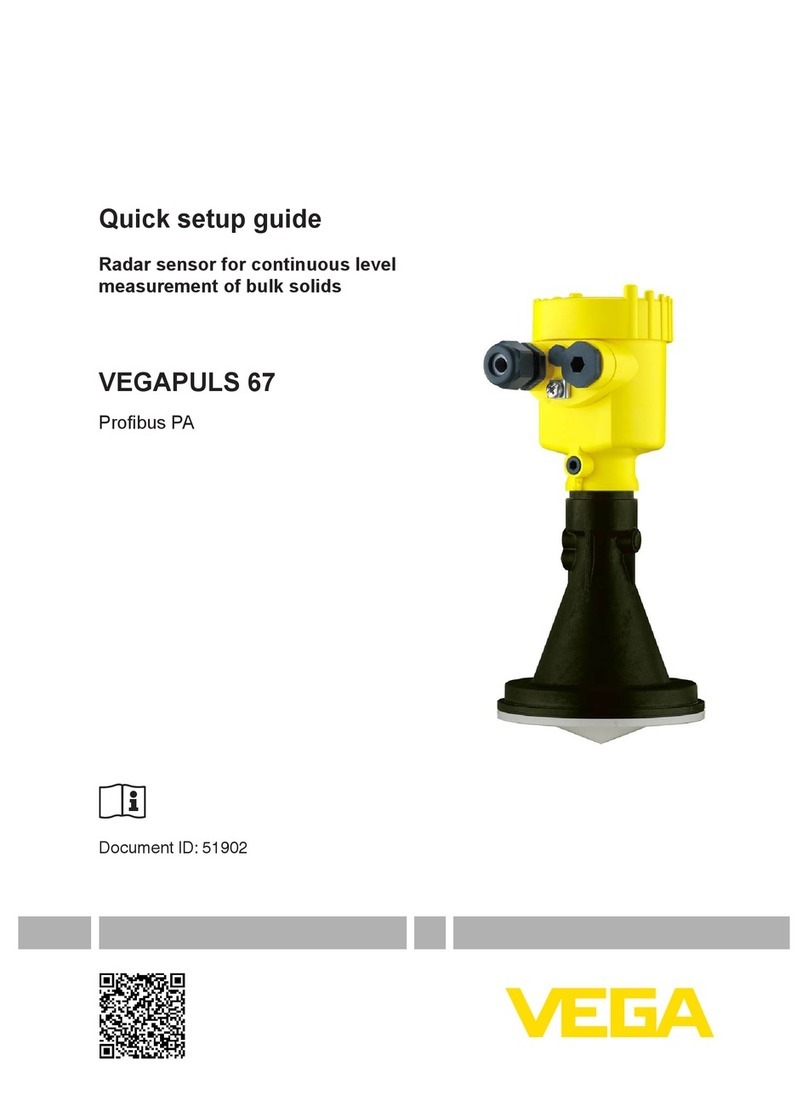
Vega
Vega VEGAPULS 67 User manual
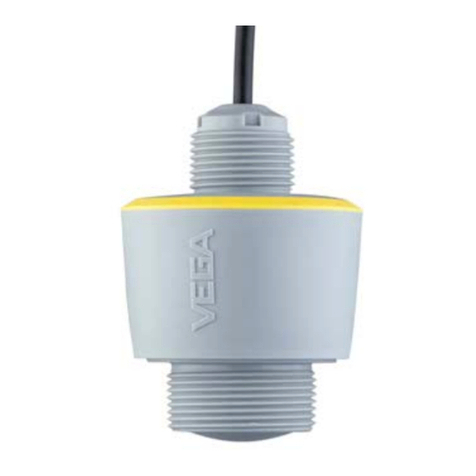
Vega
Vega VEGAPULS C 21 User manual
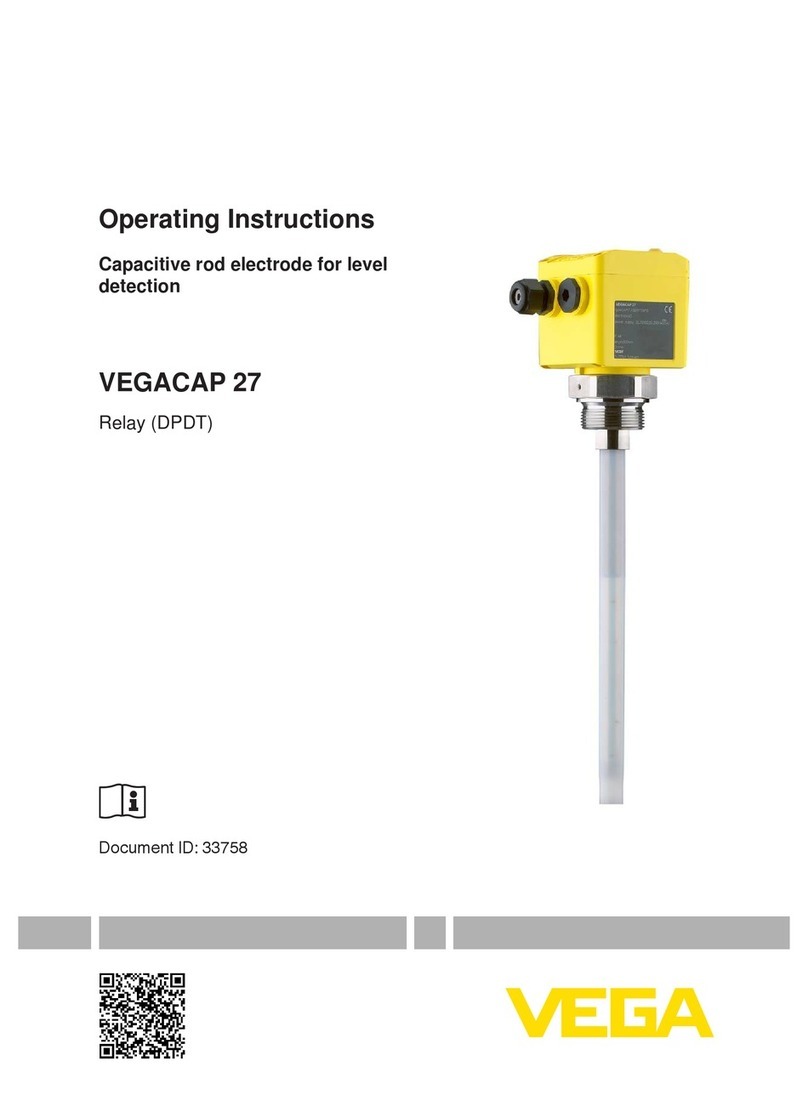
Vega
Vega VEGACAP 27 User manual

Vega
Vega VEGAPULS 67 User manual

Vega
Vega VEGAPULS 68 User manual
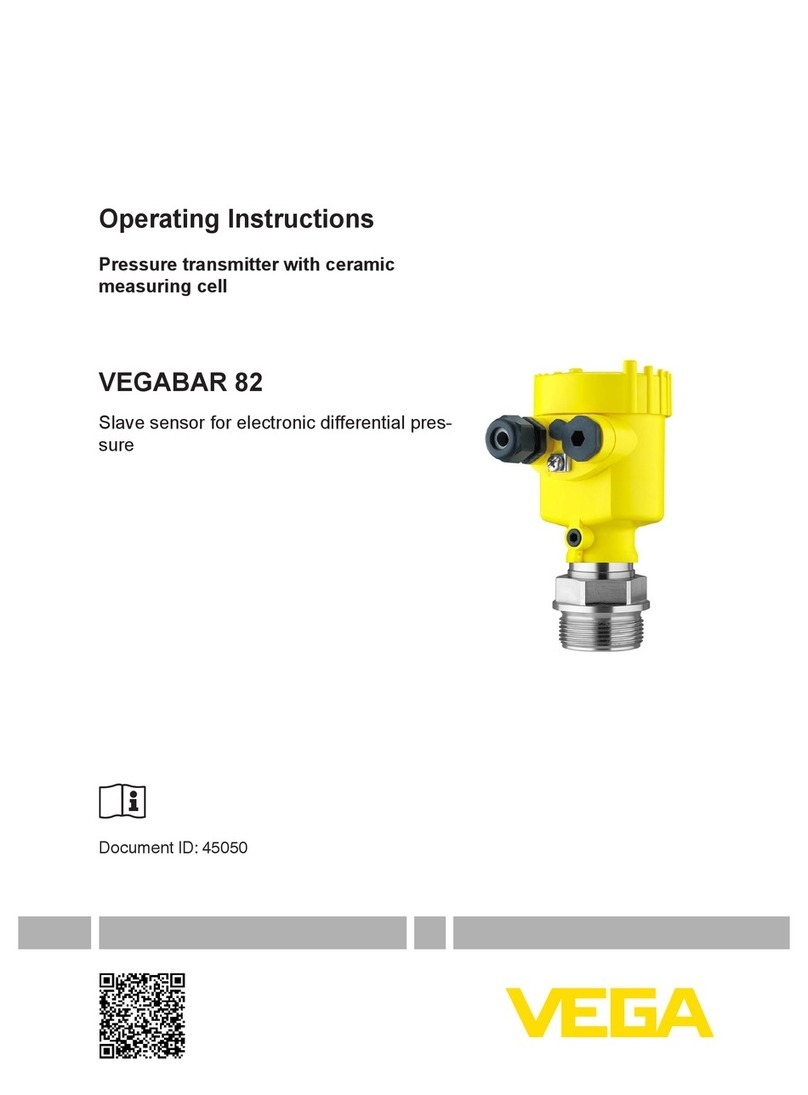
Vega
Vega VEGABAR 82 User manual
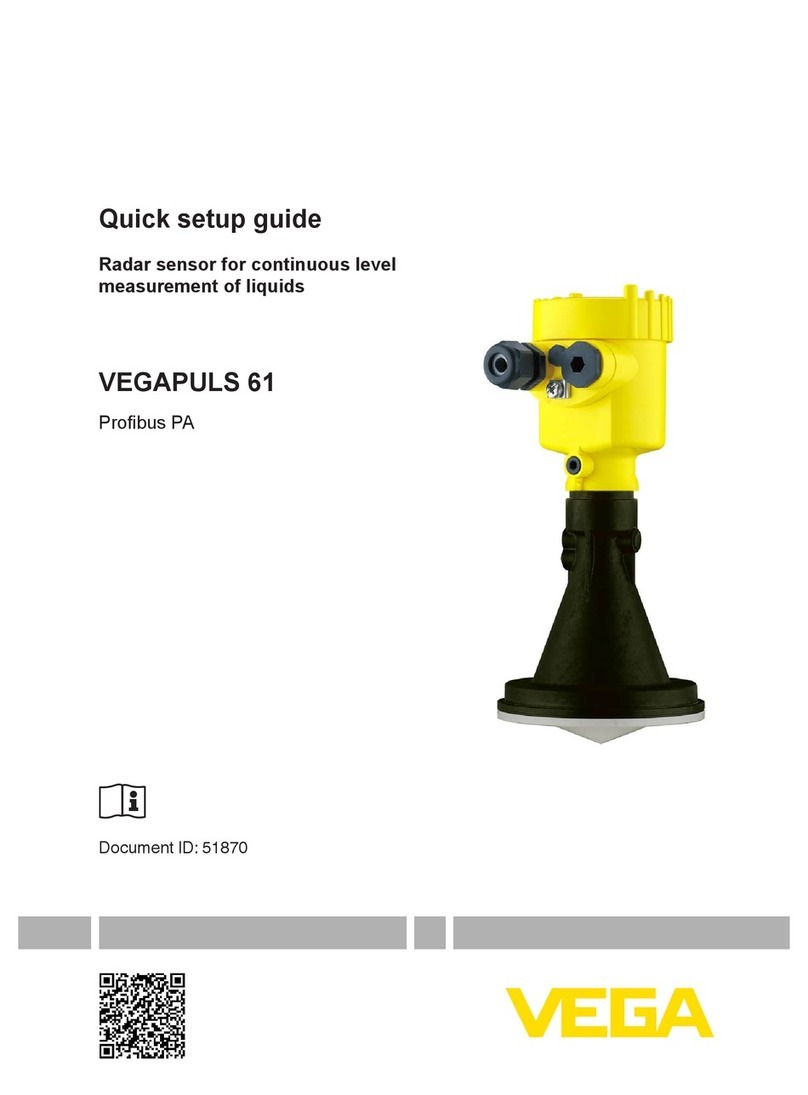
Vega
Vega VEGAPULS 61 User manual
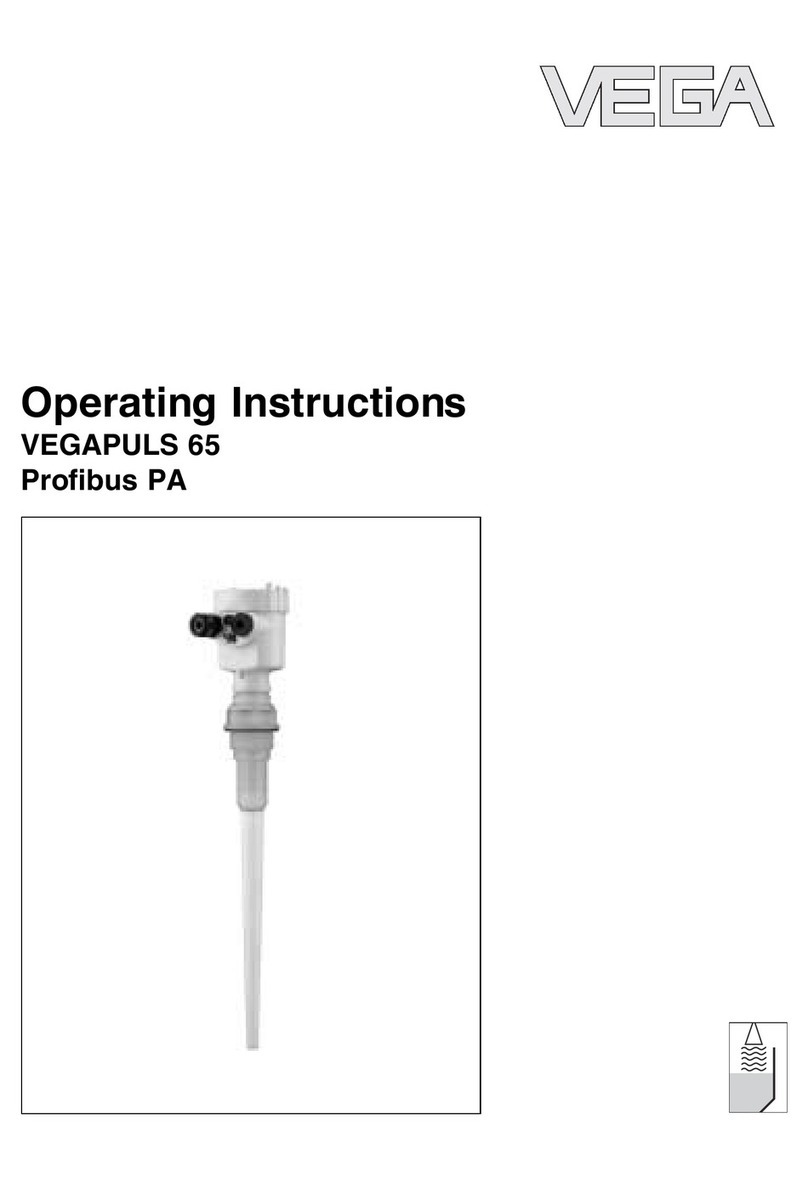
Vega
Vega VEGAPULS 65 User manual

Vega
Vega VEGAFLEX 65 User manual
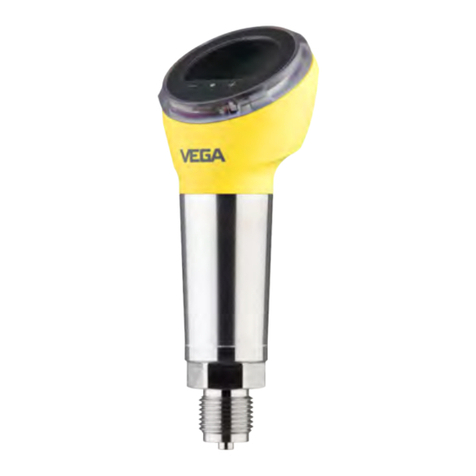
Vega
Vega VEGABAR 39 User manual

Vega
Vega VEGAFLEX 65 User manual
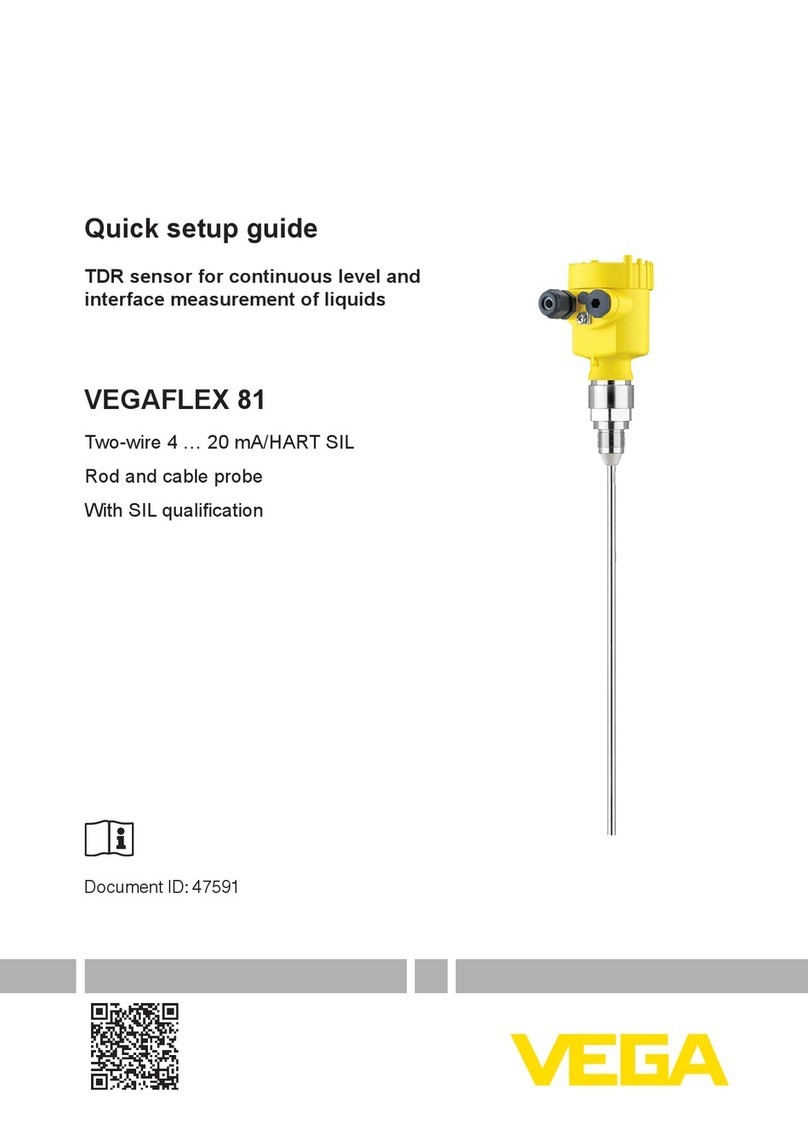
Vega
Vega VEGAFLEX 81 User manual
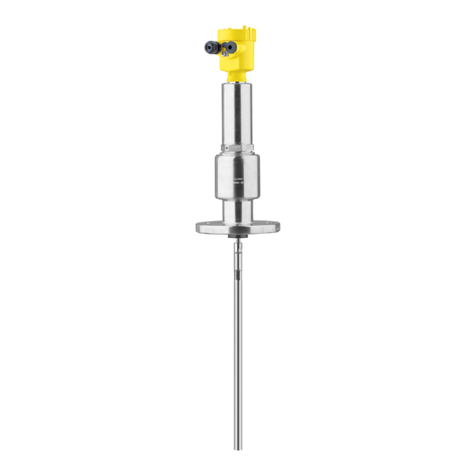
Vega
Vega VEGAFLEX 86 User manual

Vega
Vega VEGAPULS 63 User manual

Vega
Vega VEGAFLEX 86 User manual
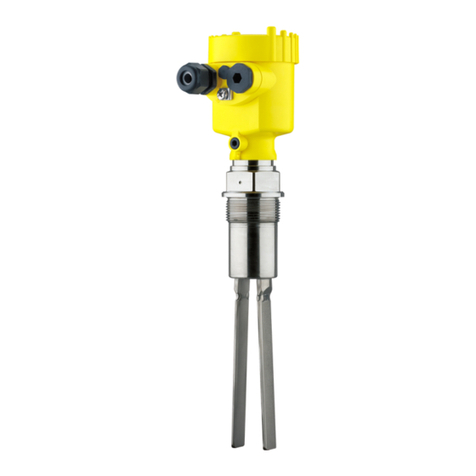
Vega
Vega VEGAWAVE 61 Instruction Manual
